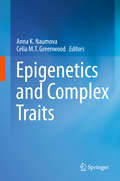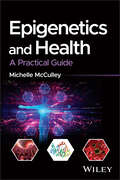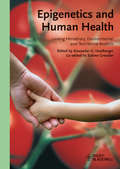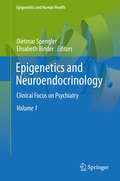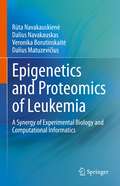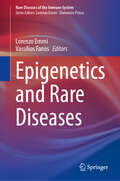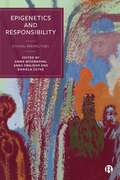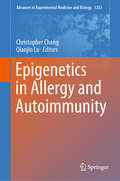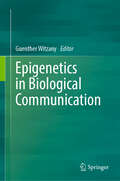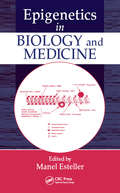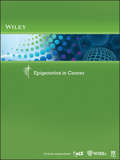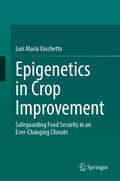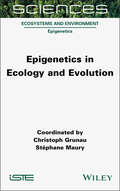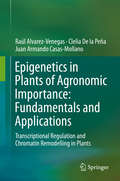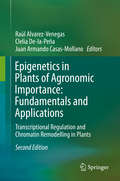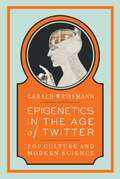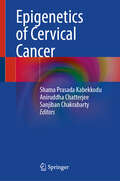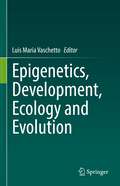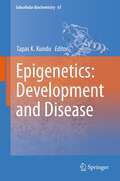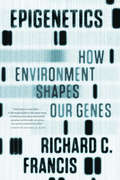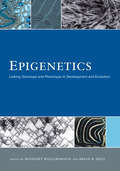- Table View
- List View
Epigenetics and Cancer
by Fazlul H. SarkarOverall, this book illustrates the complexities of the regulation and deregulation of genes mediated through epigenetics in the development and progression of human malignancies. All the articles have been carefully chosen to represent several cancer systems with state of our knowledge on the role of epigenetic deregulation of microRNAs (miRNAs) and their target mRNAs along with epigenetic deregulation of mRNAs. This book also illustrates the role of several dietary agents, collectively called nutraceuticals or natural agents in modulating the epigenetic reprogramming of miRNAs and mRNAs for the prevention and/or treatment of human malignancies. It is well known that genetic aberrations, especially inherited through parents (somatic genetic alterations) contribute to the development of less than 10% of all cancer yet epigenetic alterations in genes especially through selective methylation and acetylation appears to be responsible for the development and progression of the vast majority of all cancers. Therefore, understanding the role of epigenetics in the regulation of genes especially through deregulated expression of miRNAs as presented in this book will allow scientists to devise targeted therapeutic strategies for re-expression of the lost genes or down-regulate the genes that are over-expressed in order to eradicate cancer. It is hoped that targeting epigenetics will not only target cancer cells but it will also target the tumor microenvironment (more like the entire tumor environment such as the entire host) for achieving better treatment outcomes for patients diagnosed with cancer which will lead to achieve the long-term objective for complete eradication of cancer. This book contains fifteen chapters which begins with the concept of systems and network biology for investigating the epigenetics of cancer followed by a series of articles on the role of miRNAs and their target genes in the biology of pancreatic cancer and other cancers such as breast, kidney, prostate and and colon. Since it is becoming increasingly clear that cancer stem cells (CSCs) are important in the development and progression of cancer, and CSCs are important in therapeutic resistance, treatment failure and tumor recurrence, thus the importance of CSCs and epigenetics has been highlighted by a very timely article on epigenetic variations of stem cell markers in cancer including miRNAs. Moreover, just targeting heterogeneous cancer cell populations may not be optimal to eradicate tumors and for which one must take a holistic approach for developing drugs that could also target the tumor microenvironment and tumor dormancy that are regulated through epigenetics. Keeping abreast with this thought process the concluding chapter provides a concept towards curative cancer therapy with maspin, which could be a unique window of opportunity to target tumor dormancy. Therefore, it suggest that targeting the tumor dormancy and the tumor microenvironment using novel therapeutics specifically by targeting epigenetics would become the future of medicine.
Epigenetics and Complex Traits
by Anna K. Naumova Celia M.T. GreenwoodThis book will provide an overview of basic epigenetic phenomena; interaction between epigenetic and genetic factors; and the influence of epigenetic factors on inheritance. Epigenetic states may contribute to the penetrance of genetic polymorphisms or mutations and thereby modify inheritance patterns. This may result in non‐Mendelian inheritance of genetic traits such as observed in common human disease. The relationship between epigenetics and genetics, however, has not been comprehensively summarized yet. The topic is being more and more appreciated lately due to considerable advances in genomic and epigenomic approaches to study the origins of human disease. The editors will focus not only on describing epigenetic characteristics, mechanisms and results, but also on how considerations of epigenetics can alter interpretation and analysis of risks for complex traits. This book will be a resource for those who have been working in human genetics or analysis of human genetic data and are studying the impact of epigenetics on inheritance. An overview will be given of the impacts of inter‐individual variation in epigenetic states from major changes (errors in genomic imprinting) that cause congenital developmental defects to subtle changes and their impact on complex traits. The editors will discuss the relationship between epigenetic changes and genetic changes in human disease. Several chapters will also focus on statistical analysis of epigenetics effects, either in human disease genetic studies, or in population genetics.
Epigenetics and Gene Expression in Cancer, Inflammatory and Immune Diseases
by Barbara Stefanska David J. MacewanThis practical collection examines methodologies originating from the benefits of genome-wide approaches to studying epigenetics, which has opened the emerging field of epigenomics. Focusing on the areas of cancer, inflammatory and autoimmune disorders, chapters discuss three main components of the epigenome and their role in the regulation of gene expression and present a detailed method section specific to studying each component, including data analyses, troubleshooting, and feasibility in different experimental settings. The main topics are high-throughput and targeted methods for DNA methylation analysis, nucleosome position mapping, studying epigenetic effects of gut microbiota, optical imaging for detection of epigenetic aberrations in living cells, methods for microRNA, and histone code profiling. Written for the Methods in Pharmacology and Toxicology series, the book includes the kind of detail and implementation advice to encourage success in the lab. Authoritative and easily applicable, Epigenetics and Gene Expression in Cancer, Inflammatory and Immune Diseases aims to provide pharmacologists, molecular biologists, bioinformaticians, and toxicologists with a vital background on epigenetics and state-of-the-art techniques in epigenomics.
Epigenetics and Health: A Practical Guide
by Michelle McCulleyEpigenetics and Health An incisive and contemporary discussion of epigenetic phenomena applied to human health and disease Epigenetics and Health: A Practical Guide delivers a thorough and insightful exploration of the basic principles of gene function, gene regulation, and gene expression. The author explains how epigenetic modifications alter gene expression and demonstrate the role played by environmental factors—including nutrition, exercise, toxins, and stress—in gene regulation, as well as their potential health consequences. The book presents current methods for analyzing epigenetic variation, including NGS applications and bioinformatic analysis. Readers will be encouraged to question, analyze, and critically appraise the literature on epigenetics to further develop their understanding. They’ll also find: Explorations of epigenetic mechanisms, homeostasis, and the potential for manipulating the epigenome Practical discussions of methods for epigenetic analyses How to address cancer epigenetics, mental health epigenetics, and guidance on developing an epigenetics research project Epigenetics and Health: A Practical Guide will benefit practicing geneticists and medical geneticists seeking insights into epigenetic phenomena applied to human health and disease.
Epigenetics and Human Health: Linking Hereditary, Environmental and Nutritional Aspects
by Alexander G. Haslberger Sabine GresslerAfter first introducing the concept of epigenetics, this handbook and ready reference provides an overview of the main research on epigenetics. It adopts a multidisciplinary approach, involving molecular biology, molecular epidemiology and nutritional science, with a special focus of the book is on disease prevention and treatment. Of interest to all healthcare-related professionals as well as nutritionists, and the medical community focusing on disease prevention.
Epigenetics and Neuroendocrinology
by Dietmar Spengler Elisabeth BinderThe field of neuroendocrinology has extended from the initial interest in the hypothalamic control of pituitary secretion to embrace multiple reciprocal interactions between the central nervous system (CNS) and endocrine systems in the coordination of homeostasis and various physiological responses from adaptation to disease. Most recently, epigenetic mechanisms were recognized for their role in the development of the neuroendocrine axes as well as in the mediation of gene-environment interactions in stress-related psychiatry disorders.
Epigenetics and Proteomics of Leukemia: A Synergy of Experimental Biology and Computational Informatics
by R¯uta Navakauskien˙e Dalius Navakauskas Veronika Borutinskait˙e Dalius Matuzevi˘ciusThis book reviews the current state of epigenetics and proteomics of leukemia and introduces the methods that are important to process and evaluate these factors in leukemia. In particular, epigenetic modifiers and their inhibitors in leukemia treatment as well as approaches to the epigenetic treatment of leukemia are covered. Various computational methods for proteome analysis are also described in detail, including 2DE fractionation and visualization, proteomic data processing, image acquisition and data anlaysis, and more. Protein localization in leukemia is also covered, in addition to the future of leukemia therapy. Epigenetics and Proteomics of Leukemia is an ideal book for advanced biomedical scientists and students, medical doctors and students, bioinformatics and health informatics researchers, computational biologists, structural biologists, systems biologists, and bioengineers.
Epigenetics and Rare Diseases (Rare Diseases of the Immune System)
by Lorenzo Emmi Vassilios FanosEpigenetics, as well as all -omics fields of study, such as transcriptomics, proteomics and metabolomics, have caused a revolution in all branches of medicine in recent years. This book provides a detailed evidence-based overview of the latest developments in how the recent acquisitions on the human genome and epigenome is relevant, and how it impacts our understanding of rare diseases of the immune system. The first part features the evolving thread from genetics to epigenetics, their molecular basis, endocrine disruptors, as well as chapters devoted to the fetal programming hypothesis and functional basis of neurodevelopment, and the placenta as originating element. Successive chapters include contributions on the impact of epigenetics on cancer, as well as a comprehensive array of disorders as autoimmune disorders, allergic and metabolic diseases, systemic vasculitis, aging and inflammatory diseases, neurological and psychiatric conditions. The overview closes with considerations on the &“-Omics&” revolution and precision medicine, and the reflection of epigenetics on the microbiome. By providing guidance on how the latest information can be applied by the medical practitioner in day-to-day clinical practice, and collating the latest developments in rare diseases treatments to the &“omics&” that are relevant for the clinician while advocating for a patient-centered approach, Epigenetics and Rare Diseases will be a valued resource for clinicians, healthcare professionals, and patient associations.
Epigenetics and Responsibility: Ethical Perspectives
by Emma Moormann, Anna Smajdor and Daniela CutasEPUB and EPDF available Open Access under CC-BY-NC-ND licence. We tend to hold people responsible for their choices, but not for what they can’t control: their nature, genes or biological makeup. This thought-provoking collection redefines the boundaries of moral responsibility. It shows how epigenetics reveals connections between our genetic make-up and our environment. The essays challenge established notions of human nature and the nature/nurture divide and suggest a shift in focus from individual to collective responsibility. Uncovering the links between our genetic makeup, environment and experiences, this is an important contribution to ongoing debates on ethics, genetics and responsibility.
Epigenetics in Allergy and Autoimmunity (Advances in Experimental Medicine and Biology #1253)
by Christopher Chang Qianjin LuThis book will address the growing roles of epigenetics in disease pathogenesis, and review the contribution of epigenetic modifications to disease onset and progression. The roles that epigenetics plays in facilitating effects of the environment on allergy and immunologic diseases will be reviewed. The book is divided into three parts – the first is an introduction to epigenetics and the methods that have been developed to study epigenetics, the second addresses epigenetics in allergic diseases and the third part will cover epigenetics in autoimmune diseases. With the rapid expansion of knowledge of how genes are regulated and how this regulation affects disease phenotypes, this book will be attractive to experienced researchers as well as those just launching an epigenetics research program. It will also be of interest to allergist, immunologists, rheumatologists and dermatologist who are engaged in clinical practice as a resource for understanding the basis for personalized and precision medicine. For example, the role that epigenetics plays in the pathogenesis in various allergic and autoimmune disorders and how this determines disease phenotypes will be covered extensively in this book. This book will thus help fill the gap in available resources on epigenetics in allergy and autoimmune diseases.
Epigenetics in Biological Communication
by Guenther WitzanyEvery cell, tissue, organ and organism is competent to use signs to exchange information reaching common coordinations and organisations of both single cell and group behavior. These sign-mediated interactions we term biological communication. The regulatory system that works in development, morphology, cell fate and identity, physiology, genetic instructions, immunity, memory/learning, physical and mental disease depends on epigenetic marks. The communication of cells, persistent viruses and their defectives such as mobile genetic elements and RNA networks ensures both the transport of regulatory instructions and the reprogramming of these instructions. But how are the different states of the epigenome orchestrated? The epigenetic pathways respond to various signaling cues such as DNA methylation, histone variants, histone modifications, chromatin structure, nucleosome remodeling, and epigenetic interactions. Epigenetic signals are responsible for the establishment, maintenance and reversal of transcriptional states that are fundamental for the cell's ability to memorize past events, such as changes in the external environment, socio-sphere or developmental cues. External signals trigger changes in the epigenome, allowing cells to respond dynamically. Internal signals direct activities that are necessary for body maintenance, and repairing damaged tissues and organs. With the emergence of epigenetic memory, organisms can fix historical and context dependent impressive experiences. Evolution from now on learnt to learn. Learning means organisms can avoid reproduction of always the same. This is key to adaptation. However, inheritance of acquired characteristics is only one of the many examples of the explanatory power of epigenetics. Behavioral epigenetics demonstrates the way in which environmental and social experiences produce individual differences in behaviour, cognition, personality, and mental health. This book assembles experts to outline the various motifs of all kinds of epigenetic regulation of cells throughout their lives.
Epigenetics in Biology and Medicine
by Manel EstellerAnomalous epigenetic patterns touch many areas of study including biomedical, scientific, and industrial. With perspectives from international experts, this resource offers an all-inclusive overview of epigenetics, which bridge DNA information and function by regulating gene expression without modifying the DNA sequence itself. Epigenetics, in its
Epigenetics in Cancer (Life Science Research Fundamentals)
by WileyEpigenetics is the study of heritable changes in gene expression or cellular phenotype, caused by mechanisms other than changes in the DNA sequence. Examples include DNA methylation and histone modification. These changes may remain through cell divisions and multiple generations. Epigenetic differences among individuals may account for some of the differences between monozygotic (identical) twins. Aberrant DNA methylation is also frequently associated with human aging and diseases, such as cancer. This collection of overviews and laboratory protocols provides crucial, distilled information about the roles of epigenetics in cancer development. The overviews are geared for research scientists who need to learn more about the current understanding of epigenetic variation in humans and how the processes of DNA methylation and histone modification are regulated. The protocols give step-by-step instructions on how to detect DNA methylation using various methods such as MAPit, CHARM (arrays) and methylation-specific PCR. This e-book — a curated collection from eLS, WIREs, and Current Protocols — offers a fantastic introduction to the fields of genetics, genomics, and oncogenesis for students or interdisciplinary collaborators.
Epigenetics in Cardiac Disease (Cardiac and Vascular Biology #1)
by Johannes Backs Timothy A. McKinseyThis book describes important advances in our understanding of how environmental conditions affect cardiac gene expression through epigenetic mechanisms. Further, it discusses the roles of chromatin modifications (in particular DNA methylation and histone modifications) and of chromatin regulators in the context of cardiac diseases. The book provides readers with an overview of our current understanding of epigenetic regulation in the heart, and will stimulate further research in this exciting field. Edited and written by internationally respected experts, it addresses the needs of professors, students and researchers working in the fields of cardiac biology and epigenetics.
Epigenetics in Crop Improvement: Safeguarding Food Security in an Ever-Changing Climate
by Luis María VaschettoEpigenetics encompasses all changes in gene expression that occur without alterations to the DNA sequence. These modifications involve DNA methylation, histone modifications, and ncRNA pathways. Plants have evolved remarkable resilience to environmental challenges mediated by epigenetic modifications rather than genetic variation. Epigenetic variation provides a means for designing crop varieties with enhanced resilience to abiotic stresses, such as drought, salinity, and extreme temperatures. By understanding how epigenetic information systems interact among them and with other canonical genetic pathways, we can develop crops better equipped to withstand the challenges of climate change, ultimately contributing to global food security. Epigenetics in Crop Improvement: Safeguarding Food Security in an Ever-Changing Climate is primarily a comprehensive guide that explores the role of epigenetics in plant growth, development, and adaptation. This book also offers a valuable resource for anyone looking to investigate and develop innovative strategies for enhancing crop resilience and productivity in the face of climate change.
Epigenetics in Ecology and Evolution (ISTE Invoiced)
by Christoph Grunau Stéphane MauryGenetics and its mysterious little sister, epigenetics, have deep roots in the history of biology. Today, epigenetics is of paramount importance in not only the fundamental sciences, but also in life science applications, ranging from molecular biology, and disease diagnosis and treatment, to agriculture. Epigenetics in Ecology and Evolution traces the history of the concept of epigenetics in biology and describes the molecular mechanisms concerned. It examines the contributions that the emerging discipline of epigenetics has made to the fields of ecology and evolution, regarding both plant and animal organisms, as well as its place in our society. By exploring the importance of epigenetics at varying levels, from the cell to the organism as a whole, and even to the ecosystem, this book offers answers that are accessible to a wide audience, from scientifically curious citizens to students and professionals working in the world of biology. The aim is to enable everyone to acquire or develop a critical and informed perspective on the complex relationships between genetics and epigenetics.
Epigenetics in Oncology (Cancer Treatment and Research #190)
by Jun Lu Jianjun Chen G. Greg WangThis book addresses Epigenetics in Cancer and covers the most recent advances in RNA/histone/DNA epigenetics in Oncology. RNA/histone/DNA epigenetics have been shown to play pivotal roles in cancer initiation, progression, maintenance and drug response/resistance, tumor microenvironment, cancer stem cell self-renewal, cancer metabolism, and tumor immune evasion. In particular, research in RNA cancer epigenetics has made impressive progress in the last few years.Individual chapters in Part I (focusing on RNA epigenetics) are devoted to RNA modifications in Cancer Metabolism and Microenvironment, Cancer Stem Cell Biology, Immune Surveillance, Solid Tumors and Tumor Immunity, and Hematopoietic Malignancies, as well as to RNA editing in Cancer. Chapters in Part II and III of the book focus on histone epigenetics and DNA epigenetics, respectively.By familiarizing readers with the latest developments in this complex and challenging field, the book offers a valuable resource for scientists, graduate students and clinicians alike.
Epigenetics in Plants of Agronomic Importance: Fundamentals and Applications
by Raúl Alvarez-Venegas Clelia De la Peña Juan Armando Casas-MollanoOver the past decades, chromatin remodelling has emerged as an important regulator of gene expression and plant defense. This book provides a detailed understanding of the epigenetic mechanisms involved in plants of agronomic importance. The information presented here is significant because it is expected to provide the knowledge needed to develop in the future treatments to manipulate and selectively activate/inhibit proteins and metabolic pathways to counter pathogens, to treat important diseases and to increase crop productivity. New approaches of this kind and the development of new technologies will certainly increase our knowledge of currently known post-translational modifications and facilitate the understanding of their roles in, for example, host-pathogen interactions and crop productivity. Furthermore, we provide important insight on how the plant epigenome changes in response to developmental or environmental stimuli, how chromatin modifications are established and maintained, to which degree they are used throughout the genome, and how chromatin modifications influence each another.
Epigenetics in Plants of Agronomic Importance: Transcriptional Regulation and Chromatin Remodelling in Plants
by Raúl Alvarez-Venegas Juan Armando Casas-Mollano Clelia De-la-PeñaOver the past few decades, chromatin modulation has emerged as an important regulator of gene expression. This second edition provides detailed information on the epigenetic mechanisms in plants, illustrating the value of this research in plants of agronomic importance. It examines recent advances regarding plants’ epigenetic regulation in response to abiotic and biotic types of stress; the epigenetic basis of plant immunity; evolution and functions of plant histones; epigenetic variation and plant breeding; and epigenome editing and crop improvement. The content is intended to promote the development of future biotechnologies to manipulate and selectively activate/inhibit proteins and metabolic pathways to counter pathogens, to treat important diseases, and to increase crop productivity. The development of new fields, like epigenome editing and RNA epigenetics, will certainly improve our understanding of currently known epigenetic modifications and their roles in e.g. host-pathogen interactions, crop productivity, and in response to environmental stimuli. This volume contains twelve new/revised chapters, written by an international team of experts on plant epigenetics, and addresses the needs of researchers and professionals in the fields of agronomics, crop breeding, epigenetics, plant biochemistry, plant developmental biology, and related disciplines.
Epigenetics in the Age of Twitter
by Gerald WeissmannPop culture meets cutting-edge science in this one-volume introduction to the history of science and modern biology."[Weissmann] has emerged in the last three decades as America's most interesting and important essayist. He has achieved this status both epigenetically and through Twitter, word of mouth, so to speak. . . . Much like Susan Sontag, Weissmann likes being a contemporary, and does not feel shackled by tradition. . . . This book is a joy for the heart and instructive for the mind." -ERIC KANDEL, Nobel Laureate and author of In Search of Memory"Only a mind as nimble and well traveled as Gerald Weissmann's could see, never mind make and expound on, the connections between salamanders and Prohibition . . . white blood cells, Hollywood and erectile dysfunction . . . health care reform and Marie Antoinette . . . bacteria, the Equal Rights Amendment and the "Miracle on the Hudson." Better yet, Weissmann does so with wit and insight. A fascinating tour through history, science and pop culture." -MAX GOMEZ, MD, Emmy Award-winning WCBS-TV Medical Correspondent"Erudite energy leaps from this lively commingling of art, culture and science. . . . In each [essay], Weissmann finds links between research and elements of history and pop culture, which play off each other to illuminating effect. So US politician Sarah Palin pops up in a discussion of 'Marie Antoinette syndrome'. . . and the 'meltdown' of the mythical Icarus meets the nuclear version at the Fukushima Daiichi power plant in Japan." -NatureEpigenetics, which attempts to explain how our genes respond to our environment, is the latest twist on the historic nature vs. nurture debate. In addressing this and other controversies in contemporary science, Gerald Weissmann taps what he calls "the social network of Western Civilization," including the many neglected women of science: from the martyred Hypatia of Alexandria, the first woman scientist, to the Nobel laureates Marie Curie, Christiane Nüsslein-Volhard, and Elizabeth Blackburn, among other luminaries in the field. Always instructive and often hilarious, this is a one-volume introduction to modern biology, viewed through the lens of today's mass media and the longer historical tradition of the Scientific Revolution. Whether engaging in the healthcare debate or imagining the future prose styling of the scientific research paper in the age of Twitter, Weissmann proves to be one of our most incisive cultural critics and satirists.Gerald Weissmann is director of the Biotechnology Study Center at the New York University School of Medicine and editor-in-chief of the FASEB Journal. His essays and reviews have appeared in numerous publications worldwide, including the London Review of Books and New York Times Book Review.
Epigenetics of Cervical Cancer
by Shama Prasada Kabekkodu Aniruddha Chatterjee Sanjiban ChakrabartyThis book focuses on the fundamentals of epigenetics, covering the roles of DNA methylation, histone modifications, and non-coding RNA, especially miRNA and lncRNA, in cervical cancer. The chapters discuss various methods to detect epigenetic changes and how these changes could be useful for diagnosis, prognosis, as well as epigenetic therapy. Further chapters address the up-to-date approaches and solutions to the parameterizing bottlenecks associated with the translation of these findings for the management of cervical cancer. The book is supplemented with figures and tables to aid conceptual understanding. The book is relevant for researchers, academicians, scientists, as well as medical students seeking to understand the fundamentals of cervical cancer based on environmental or genetic factors.
Epigenetics, Development, Ecology and Evolution
by Luis María VaschettoEpigenetic modifications comprise heritable gene expression changes that occur without alteration of the DNA sequence and 'co-act' with genetic factors to shape development processes and evolutionary trajectories. Multicellular organisms receive different types of environmental stimuli/stresses that trigger epigenetic modifications during development. These environmentally driven mechanisms represent an underlying cause of phenotypic diversity, especially in metazoans. This book aims to present some of the latest epigenetic insights into the development of metazoans (including humans) as an intersection between their ecology and evolution.
Epigenetics: Development and Disease
by Tapas Kumar KunduEpigenetics fine-tunes the life processes dictated by DNA sequences, but also kick-starts pathophysiological processes including diabetes, AIDS and cancer. This volume tracks the latest research on epigenetics, including work on new-generation therapeutics.
Epigenetics: How Environment Shapes Our Genes
by Richard C. FrancisGoodbye, genetic blueprint. . . . The first book for general readers ?on the game-changing field of epigenetics. The burgeoning new science of epigenetics offers a cornucopia of insights--some comforting, some frightening. For example, the male fetus may be especially vulnerable to certain common chemicals in our environment, in ways that damage not only his own sperm but also the sperm of his sons. And it's epigenetics that causes identical twins to vary widely in their susceptibility to dementia and cancer. But here's the good news: unlike mutations, epigenetic effects are reversible. Indeed, epigenetic engineering is the future of medicine.
Epigenetics: Linking Genotype and Phenotype in Development and Evolution
by Benedikt Hallgrímsson Brian K. HallIlluminating the processes and patterns that link genotype to phenotype, epigenetics seeks to explain features, characters, and developmental mechanisms that can only be understood in terms of interactions that arise above the level of the gene. With chapters written by leading authorities, this volume offers a broad integrative survey of epigenetics. Approaching this complex subject from a variety of perspectives, it presents a broad, historically grounded view that demonstrates the utility of this approach for understanding complex biological systems in development, disease, and evolution. Chapters cover such topics as morphogenesis and organ formation, conceptual foundations, and cell differentiation, and together demonstrate that the integration of epigenetics into mainstream developmental biology is essential for answering fundamental questions about how phenotypic traits are produced.

